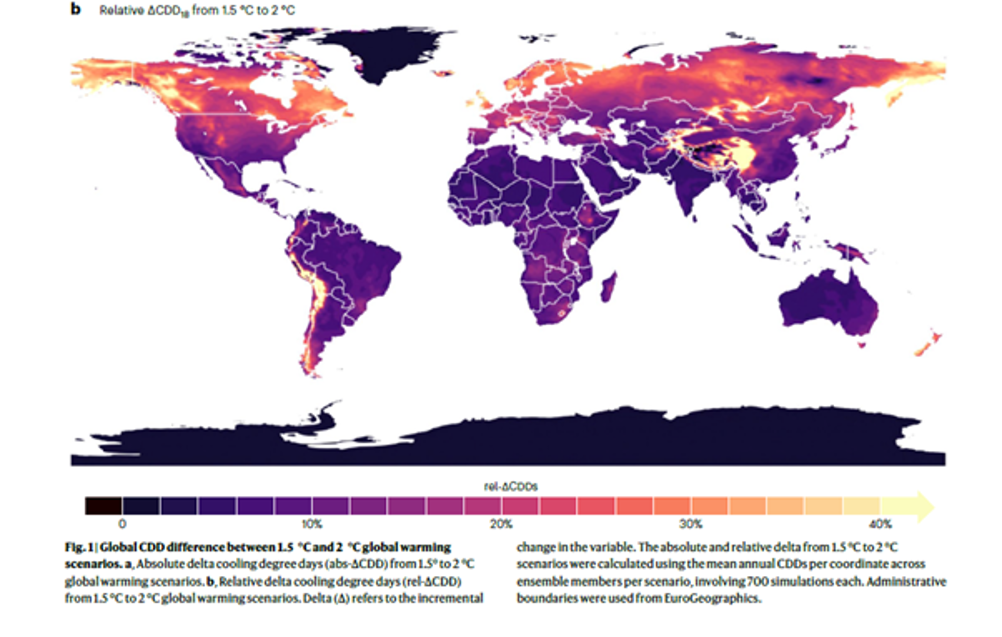In a new paper published in Nature Sustainability, the researchers mapped the cooling demand required around the world as global temperatures move from 1.5 to 2 degrees of warming – a scenario the Oxford team deems increasingly likely given current trends. While central African countries will suffer the most extreme temperatures, parts of northern Europe such as the UK, Ireland, Switzerland and Scandinavia will suffer the biggest relative shift, enduring a greater percentage increase in ‘uncomfortably hot days’ than elsewhere. What’s more, these countries are extremely unprepared for the cooling demands that the shift will bring, according to the Oxford team.
Related content
“Right now, for example, sustainable cooling barely has a mention in the UK’s net zero strategy,” said study co-author Dr Radhika Khosla, Associate Professor at the Smith School of Enterprise and the Environment and leader of the Oxford Martin Programme on the Future of Cooling.
“Without adequate interventions to promote sustainable cooling we are likely to see a sharp increase in the use of energy-guzzling systems like air conditioning, which could further increase emissions and lock us into a vicious cycle of burning fossil fuels to make us feel cooler while making the world outside hotter.”
The analysis used the concept of ‘cooling degree days’ (CDD), a method widely employed in research and weather forecasting to determine whether cooling would be needed on a particular day to keep people comfortable. The researchers modelled the world in 60km grids every six hours to produce the temperature averages in the study, providing accurate measurements from across the globe.
Ireland was the country with the highest percentage change in relative CDD, predicted to experience a 37.9 per cent increase in CDD as Earth moves from 1.5 to 2 degrees of warming. Switzerland was in 2nd place with 30.3 per cent, followed by the UK (29.8 per cent), Norway (28.2 per cent), Finland (27.8 per cent) and Sweden (27.6 per cent).

Eight of the 10 countries with the greatest relative increase in uncomfortably hot days are expected to be in Northern Europe, with Canada and New Zealand completing the list. According to the Oxford team, one of the key reasons for these countries topping the relative CDD table is the focus on retaining heat in winter rather than keeping cool over the summer months.
“In the northern hemisphere and Europe the buildings are made to keep heat in, and so we are at risk in the summer time when heatwaves come or high temperatures in general come,” explained study lead author Dr Nicole Miranda, programme manager and researcher on the Future of Cooling Programme of the Oxford Martin School.
“Even a small increase in the temperatures (is) actually showing a high relative change which can be very impactful and make these countries more vulnerable to needing more cooling.”
In a note of hope, co-lead author Dr Jesus Lizana said that we have the tools to adapt to these cooling demands without exclusively relying on energy-hungry solutions like air conditioning. Natural ventilation, external solar protection, ceiling fans and personal cooling were all mooted as potential solutions to the looming threat.
“If we adapt the built environment in which we live, we won’t need to increase air conditioning,” said Lizana. “But right now, in countries like the UK, our buildings act like greenhouses - no external protection from the sun in buildings, windows locked, no natural ventilation and no ceiling fans. Our buildings are exclusively prepared for the cold seasons.”












McMurtry Spéirling defies gravity using fan downforce
Ground effect fans were banned from competitive motorsport from the end of the 1978 season following the introduction of Gordon Murray's Brabham...